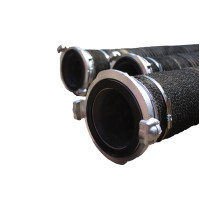How often should fire hoses be rewound?
- Thupm31Europe/Kiev 18:33:13
- Reviews: 0
- Views: 468
-

Rewinding fire hoses is an essential part of the maintenance of firefighting equipment. Regular rolling helps preserve their functional properties, prevent wear and tear, and maintain readiness for use in emergency situations. However, the frequency and method of this procedure depend on storage and operating conditions, as well as local regulations.
Why is fire hose rolling necessary?
Over time, fire hoses stored in the same position lose flexibility at the bends. This can lead to cracks, loss of tightness, rot, and mold formation. Rolling serves several important functions:
- Prevention of damage. Changing the fold line reduces the risk of cracks and abrasions.
- Detection of defects. During rolling, specialists inspect the hose for damage, deformations, and ruptures.
- Maintaining flexibility and strength. Regular rewinding prevents material compression and ensures the hose's longevity.
- Ensuring tightness. Preventive rolling allows leaks to be detected in time and measures to be taken before serious problems arise.
Rolling frequency
The standard rolling frequency of fire hoses is determined by regulatory documents and depends on their operating conditions:
- Hoses stored in fire cabinets:
According to recommendations, such hoses should be rolled at least once a year. This allows timely detection of damage and prevents wear at bending points. - Hoses stored in warehouses:
Hoses stored for long periods should be rolled more frequently—once every three months. This frequency is due to the increased risk of material compression during prolonged storage. - Hoses after use:
After each use, whether during training or actual firefighting, the hose must be washed, dried, and rewound. - New hoses:
Even new hoses should be rewound before being put into operation. Factory single-coiling may cause twisting and hinder quick access to the extinguishing agent.
Rolling procedure
Rewinding fire hoses involves several stages:
- Preparation:
The hose is unrolled, washed, and thoroughly dried. This is done to remove contaminants and prevent material decay. - Inspection for defects:
A visual inspection helps identify cracks, deformations, leaks, or other damages. If serious defects are found, the hose is removed from service. - Rewinding:
The hose is coiled onto a new edge at an angle to avoid repeated bends in the same spots. Rewinding can be done manually or using specialized equipment.
Documentation
Each facility maintains a fire hose rolling log, which records:
- Date of the procedure.
- Hose inventory number.
- Storage location.
- Person responsible for rolling.
After the procedure, a report is drawn up and signed by the commission members, then stored along with the log. This ensures transparency and allows for quick verification of when and by whom the last rolling was performed.
Regular rolling of fire hoses is not just a formality but a crucial preventive measure that ensures the longevity and reliability of firefighting equipment. Adhering to regulations, timely inspections, and hose rewinding are key to their effectiveness in the event of a fire.
Рукав всмоктуючий Ø100 з ГРВ - 100 мм
Рукав всмоктуючий Ø100 мм в зборі з двома гайками ГРВ - 100, призначений для забору і підведення вод..
₴0.00грн








